Congregation for the Oriental Churches
| Latin: Congregatio pro Ecclesiis Orientalibus | |
 Coat of arms of the Holy See | |
 Palazzo dei Convertendi, seat of the Congregation for the Eastern Churches | |
| Congregation overview | |
|---|---|
| Formed | January 6, 1862 |
| Preceding agencies |
|
| Type | Congregation |
| Headquarters | Palazzo dei Convertendi, Rome, Italy |
| Congregation executives |
|
| Part of a series on the |
| Roman Curia |
|---|
 |
|
|
The Congregation for the Oriental Churches (Latin: Congregatio pro Ecclesiis Orientalibus) is a dicastery of the Roman Curia, and the curial congregation responsible for contact with the Eastern Catholic Churches for the sake of assisting their development and protecting their rights. It also maintains whole and entire in the one Catholic Church, alongside the liturgical, disciplinary, and spiritual patrimony of the Latin Rite, the heritage and Eastern Catholic canon law of the various Eastern Catholic traditions. It has exclusive authority over the following regions: Egypt and the Sinai Peninsula, Eritrea and northern Ethiopia, southern Albania and Bulgaria, Cyprus, Greece, Iran, Iraq, Lebanon, Israel (and Palestinian territories), Syria, Jordan and Turkey,[1] and also oversees jurisdictions based in Romania, Southern Italy, Hungary, India and Ukraine. It was founded by the Motu Proprio Dei Providentis of Pope Benedict XV as the "Sacred Congregation for the Oriental Church" on 1 May 1917 and "considers those matters, whether concerning persons or things, affecting the Catholic Oriental Churches."[2]
Structure[]
Patriarchs and Major Archbishops of the Oriental Churches, and the president of the Pontifical Council for Promoting Christian Unity, are members of this Congregation by virtue of the Law itself.[3] The consultors and officials are selected reflecting the diversity of rites.[4]
Authority[]
This congregation has authority over:
- all matters which relate to the Oriental Churches referred to the Holy See (structure and organisation of the Churches; exercise of the offices of teaching, sanctifying and ruling; status, rights, and obligations of persons), and
- the ad limina visits of Eastern bishops.[5]
This congregation's authority does not include the exclusive authority of the Congregations for the Doctrine of the Faith and for the Causes of Saints, of the Apostolic Penitentiary, the Supreme Tribunal of the Apostolic Signatura, and the Tribunal of the Roman Rota, including what pertains to dispensations from a marriage ratum sed non consummatum ('"ratified but not consummated").[note 1] In matters which affect the Eastern as well as the Latin Churches, the Congregation operates, if the matter is important enough, in consultation with the Dicastery that has authority in the matter for the Latin Church.[6] The Latin Patriarchate of Jerusalem is exempt from the authority of the Congregation, being directly subject to the Holy See.[7]
The Congregation pays special attention to communities of Eastern Catholic faithful who live in the territory of the Latin Church and attends to their spiritual needs by providing visitors and even their own hierarchs, so far as possible and where numbers and circumstances require, in consultation with the Congregation competent to establish Particular Churches in the region.[8]
In regions where the Eastern Churches have been dominant from ancient times, apostolic and missionary activity is solely the responsibility of this Congregation, even if the above is carried out by Latin Rite missionaries.[9]
The congregation collaborates with the Pontifical Council for Promoting Christian Unity in matters that concern relations with non-Catholic Eastern Churches and with the Pontifical Council for Interreligious Dialogue in matters within the scope of the latter.[10]
History[]
| Part of a series on |
| Particular churches sui iuris of the Catholic Church |
|---|
| Particular churches are grouped by rite. |
| Alexandrian Rite |
| Armenian Rite |
| Byzantine Rite |
|
| East Syriac Rite |
|
| Latin liturgical rites |
| West Syriac Rite |
|
|
|
On 6 January 1862, Pope Pius IX established the Congregatio de Propaganda Fide pro negotiis ritus orientalis, a section of the Congregation for the Propagation of the Faith "for the affairs of the Oriental Rite", with the apostolic constitution Romani Pontifici.[11] Pope Benedict XV declared it independent on 1 May 1917 with the motu proprio Dei Providentis and named it Congregatio pro Ecclesia Orientali. Pope Paul VI gave it its current name by adopting the plural Congregatio pro Ecclesiis Orientalibus with the apostolic constitution Regimini Ecclesiae Universae of 15 August 1967, reflecting the major decree Orientalium Ecclesiarum of the Second Vatican Council.[1]
Structure in 1917[]
In May 1917, Pope Benedict XV established a congregation for the Eastern Catholic Churches.[12] It was presided over by the pope and included several Cardinals, one of whom filled the role of Secretary.[13]
There were also Councillors, chosen from among the more distinguished clergy and those experienced in things oriental.[13]
The current Cardinal Prefect of the Congregation is Leonardo Sandri.[14] The Archbishop Secretary is Giorgio Gallaro.[15] The Undersecretary is Monsignor .[16]
Leadership[]
From 1917 to 1967, the pope held the title of Prefect of the Congregation.
| No. | Name | From | Until | Prefect/Appointer | |
|---|---|---|---|---|---|
| 1 | 
|
Niccolò Marini | 1917 | 1922 | Benedict XV |
| 2 | 
|
Giovanni Tacci Porcelli | 1922 | 1927 | Pius XI |
| 3 | 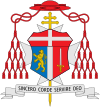
|
Luigi Sincero | 1927 | 1936 | Pius XI |
| 4 | 
|
Eugène-Gabriel- Gervais-Laurent Tisserant |
1936 | 1959 | Pius XI |
| 5 | 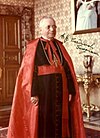
|
Amleto Giovanni Cicognani |
1959 | 1961 | John XXIII |
| 6 | 
|
Gabriel Acacius Coussa | 1961 Pro-Prefect |
1962 Prefect |
John XXIII |
| 7 | 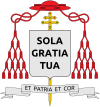
|
Gustavo Testa | 1962 | 1967 | John XXIII |
| No. | Name | From | Until | Appointer | |
|---|---|---|---|---|---|
| 1 | 
|
Gustavo Testa | 15 August 1967 | 13 January 1968 | Paul VI |
| 2 | 
|
Maximilien de Furstenberg |
15 January 1968 | 8 February 1973 | Paul VI |
| 3 | 
|
Paul-Pierre Philippe | 6 March 1973 | 27 June 1980 | Paul VI |
| 4 | 
|
Władysław Rubin | 27 June 1980 | 30 October 1985 | John Paul II |
| 5 | 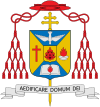
|
Duraisamy Simon Lourdusamy |
30 October 1985 | 24 May 1991 | John Paul II |
| 6 | 
|
Achille Silvestrini | 24 May 1991 | 7 September 2000 | John Paul II |
| 7 | 
|
Ignatius Moussa Daoud | 25 November 2000 | 9 June 2007[14] | John Paul II |
| 7 | 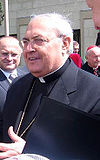
|
Leonardo Sandri | 9 June 2007[14] | Incumbent | Benedict XVI |
References[]
- ^ Jump up to: a b "Congregation for the Oriental Churches: Profile". vatican.va. Retrieved 2019-06-10.
- ^ Ap. Const. Pastor Bonus, Art. 56
- ^ Ap. Const. Pastor Bonus, Art. 57 §1
- ^ Ap. Const. Pastor Bonus, Art. 57 §2
- ^ Ap. Const. Pastor Bonus, Art. 58 §1
- ^ Ap. Const. Pastor Bonus, Art. 58 §2
- ^ "Exemption". Catholic Encyclopedia. Retrieved 2007-02-18.
- ^ Ap. Const. Pastor Bonus, Art. 59
- ^ Ap. Const. Pastor Bonus, Art. 60
- ^ Ap. Const. Pastor Bonus, Art. 61
- ^ Noonan, The Church Visible, pp. 69 & 537.
- ^ Norwich, Absolute Monarchs, pg. 426.
- ^ Jump up to: a b Benedict XV, Motu Proprio Dei Providentis, 2
- ^ Jump up to: a b c "Rinunce e nomine, 09.06.2007" (Press release) (in Italian). Holy See Press Office. 9 June 2007. Retrieved 3 February 2020.
- ^ "Rinunce e nomine". press.vatican.va. Retrieved 2020-09-23.
- ^ "Rinunce e nomine, 03.02.2020" (Press release) (in Italian). Holy See Press Office. 3 February 2020. Retrieved 3 February 2020.
Notes[]
- ^ This is according to the Ap. Const. Pastor Bonus, Art. 58 §2. However, on 30 August 2011, Pope Benedict XVI amended Pastor Bonus with the Motu Proprio Quaerit Semper, thereby transferring jurisdiction over marriages ratum sed non consummatum from the Congregation for Divine Worship and the Discipline of the Sacraments to a special Office at the Tribunal of the Roman Rota. The law obrogated the provision stating the "exclusive competence" of the Congregation for Divine Worship regarding these marriages, for this provision was not expressly abrogated and the Office at the Roman Rota now oversees dispensations from such marriages. (Cf. Benedict XVI, MP Quaerit Semper, accessed August 8, 2012.)
Bibliography[]
- Noonan, James-Charles, Jr. The Church Visible: The Ceremonial Life and Protocol of the Roman Catholic Church (New York: VIKING, 1996). ISBN 0670867454
- Norwich, John Julius. Absolute Monarchs: A History of the Papacy (New York: Random House, 2011).
External links[]
- Congregation for the Oriental Churches
- Christian organizations established in 1917
- Catholic organizations established in the 20th century
- 1917 establishments in Vatican City